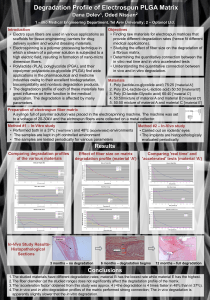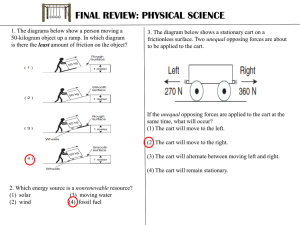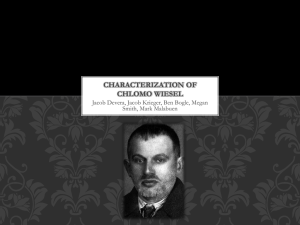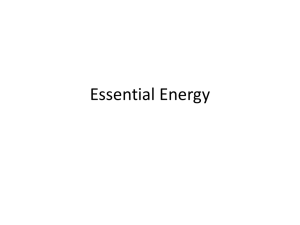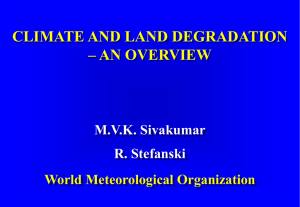8.1 Energy Degradation and Power Generation
advertisement
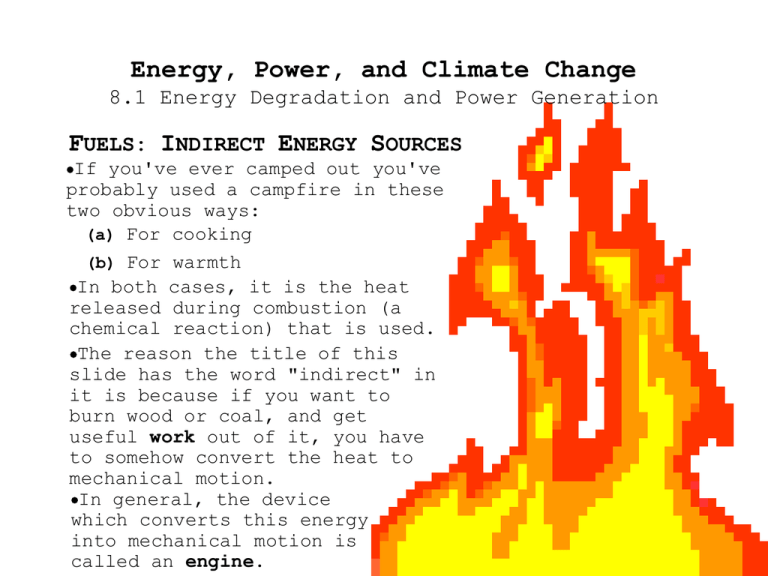
Energy, Power, and Climate Change 8.1 Energy Degradation and Power Generation FUELS: INDIRECT ENERGY SOURCES If you've ever camped out you've probably used a campfire in these two obvious ways: (a) For cooking (b) For warmth In both cases, it is the heat released during combustion (a chemical reaction) that is used. The reason the title of this slide has the word "indirect" in it is because if you want to burn wood or coal, and get useful work out of it, you have to somehow convert the heat to mechanical motion. In general, the device which converts this energy into mechanical motion is called an engine. Energy, Power, and Climate Change 8.1 Energy Degradation and Power Generation FUELS: INDIRECT ENERGY SOURCES Here is a simple means of converting heat to useable mechanical energy: A hot air balloon. One form of mechanical energy we could "extract" from the balloon is potential energy. By using it to lift a quantity of water up high, we could release the water in a stream, to turn a turbine. The turbine could be used directly to turn a winch, or it could be used indirectly to run a generator to produce electricity. Eventually, the water will run out and the balloon will have to descend to obtain more. In other words, the balloon "engine" must go through repeated cycles in order to keep producing mechanical energy. Getting the balloon back down is simple: Let it cool down by releasing its heat to the surrounding environment. FYI: All the kinetic energy of the box is converted to heat via friction. Energy, Obviously we Power, cannot convert that Climate heat back intoChange and mechanical energy to Degradation make the box travel back to where it started: 8.1 Energy and Power Generation THE SECOND LAW OF THERMODYNAMICS The second law of thermodynamics states that although it is possible to convert mechanical energy completely into thermal energy, it is NOT possible to convert all heat energy into mechanical energy. More simply phrased we may say that "it is impossible to take heat from a hot object and use it all to do work without losing some of it to the environment." The hot air balloon example illustrates this law: During its descent, all of its heat energy is lost to the environment. FYI: It is also lost during its ascent! How? FYI: During each stage of the cycle, energy is being lostChange to the Energy, Power, and Climate environment in a formDegradation that cannot be recovered for useful work. 8.1 Energy and Power Generation FYI: We call this imperfect conversion of energy from one form ENERGY into anotherDEGRADATION ENERGY DEGRADATION. Suppose we are using wood to heat up the air to FYI: energy degradation as a spreading out of our makeThink the of balloon rise. source wider surroundings. original Think energy of the woodinto asever a concentrated form of chemical energy. FYI: In terms of ENTROPY, you may view energy degradation as Weanthen burn the wood, heat to universe the increase in entropy (whichreleasing is the tendency of the environment. This has the effect of spreading toward disorganization). We begin with a very compact and out the energy into the balloon and the organized energy source (the wood) and end up with a lot of surrounding air. energy spread over largercauses areas. the balloon to thermal Some of this heatout actually rise, increasing the potential energy of the system. The rest is lost. The stream of water converts potential to kinetic energy (both forms are mechanical energy). The kinetic energy of the water is then transferred to the turbine blades, with much of it lost to the surroundings. The kinetic energy of the turbine can then be converted to electricity through use of a generator. Energy, Power, and Climate Change 8.1 Energy Degradation and Power Generation SANKEY DIAGRAMS We can show energy degradation for the hot air balloon engine with a flow chart called a Sankey diagram. High Water Falling Water Wood Turbine Chemical Energy 100 MJ Potential Energy 70 MJ Heat 30 J Kinetic Energy 60 MJ Heat 10 J Mechanical Energy 45 MJ Heat 15 J Note that each conversion has an efficiency associated with it, which can be calculated using Output 70 = 0.7 = 70% = Input 100 Conversion from wood to potential energy is, for example... Efficiency = Energy, Power, and Climate Change 8.1 Energy Degradation and Power Generation TYPICAL EFFICIENCIES Here are some examples of efficiencies: Machine Efficiency (%) Steam Locomotive 5 to 10 Human Muscle 20 to 25 Automobile less than 25 Compressor 80 Electric Motor 70 to 95 FYI: You should be able to make Sankey diagrams for each of these machines. The lost energy is unusable heat, given up to the environment. Energy, Power, and Climate Change 8.1 Energy Degradation and Power Generation TYPICAL EFFICIENCIES You may recall from biology the "efficiency" of organisms - for example a caterpillar. This flow chart illustrates energy partitioning. If we look at the caterpillar's biomass, only 33 J/200 J = 16.5% of the total energy consumed by the caterpillar becomes caterpillar. Energy, Power, and Climate Change 8.1 Energy Degradation and Power Generation TYPICAL EFFICIENCIES In fact, the higher up in the food chain you go, the less of the original energy you have left: Energy, Climate Change FYI: This EMF can bePower, produced byand moving the wire through a stationary magnetic or by moving a magneticand field past a stationary wire. 8.1 field, Energy Degradation Power Generation FYI: The polarity of the EMF can be reversed if the relative motion is GENERATING ELECTRICITY reversed (called ALTERNATING CURRENT). Electricity is one of the most useable forms of FYI: Mostwe of our electricity is produced using generators, which are in energy have because it is so easily transportable. turn by turbines, rotatedelectrons by fluids such as water a(dams), Yourun may recall which that are moving produce magnetic field. wind, or steam (coal fired or nuclear power plants). It turns out that the process is symmetric: A FYI: From the Sankey diagrams, we see that every energy conversion moving magnetic field produces moving electrons between the basic energy source and the useable form of energy results (called an electromotive force or EMF). in energy degradation. Thus a coil of wire spinning in a magnetic field will produce an EMF (aka a voltage) that can be used to drive electrical devices. B-Field Electrons Wire




